Duende
Tuesday 18 September 2012

To Bilbao to see the Hockney exhibition at the Guggenheim. Driving there, we stopped for the night in Torla, a beautiful little town at the very end of a Pyrenees valley, surrounded by vast peaks of rock ... and ate one of the best dinners we've had for years. Which is a bit surprising, because Torla mainly offers hearty fodder for starving rock-climbers - but it does have El Duende, a Michelin-listed restaurant of some local fame. We had grilled foie with chestnut cream and fruit of the forest sauce ... and tender broad beans fried with bits of duck ... and ... the only problem was being stared at by fairies.
One of them had a green face with pointed ears, and a particularly nasty grin, suggesting that it had secreted something rather repellent into the food and was waiting to see the effect. I say 'it' because the thing was naked from the waist down and seemed to have no genitalia whatsoever. The other, peering over my wife's shoulder, seemed rougher and even nastier - brown face, with pointed ears again, and gappy teeth ... plus big boots for kicking things, and carrying a heavy wooden mallet. They were not nice flimsy fairies.
I should explain - 'duende' in Spanish means something like 'fairy', except that 'imp' is probably closer to the full meaning. Since the restaurant was called El Duende, the owners had collected a few sculptures or models of fairies to decorate the dining room. What was interesting was the style of these fairly large and noticeable dolls: they all had something at least mischievous and often positively malevolent about them, nothing like those pretty little things with dragonfly wings in certain Victorian fairy tale books.
This got us thinking about the whole tradition of such supernatural creatures. They seem to exist in all cultures: think of the Little People in Ireland, green and living in little kingdoms underneath hills, playing tricks on people ... of trolls in Scandinavia, generally antisocial and to be avoided ... and of the fairies in A Midsummer Night's Dream, particularly Puck with his arrogance and callous sense of humour. All of these do things that normal boring humans can not, or would not, or dare not, do - there is something amoral and anarchic about them. They may be charming, amusing, entertaining, but in the end they don't really give a fuck. Ordinary mortal humans should treat them with caution.
A glance in Roget's Thesaurus gives these words (to quote just a selection) - elf, pixie, gnome, imp, sprite, flibbertigibbet (!), dwarf, troll, orc, hobgoblin, leprechaun, pigwidgin (what?), gremlin, dybbuk ... you see the point. There is a whole range of species that have been invented or imagined, that range from 'charming' (elf) to 'frightening' (troll). But why?
Actually, the word 'duende' itself may give a clue. The RAE, the authoritative dictionary of Spanish, gives two main definitions: a kind of spirit of place which may haunt houses ('frightening'), and a mysterious and ineffable enchantment ('charming', but much more so). The latter definition is supported by a quote "Los duendes del cante flamenco" - and this is the meaning that Lorca develops in a famous essay. He tries to define why really good flamenco can make the hair rise on the nape of the neck, suggesting that the best flamenco performers are possessed by a kind of spirit, something that is above individuals, is even superhuman. Such a spirit is so enchanting, rich and powerful that it disturbs you by shaking any sense of normality.
Duende, in the flamenco sense, is serious because it represents a more intense form of experiencing reality. Indeed, all of these creatures are embodiments of the ecstasy and terror involved in moving outside the security of the predictable. They are the spirits of risk-taking.
[And if you want to dwell a little bit more on the food, have a look at these reviews ]

